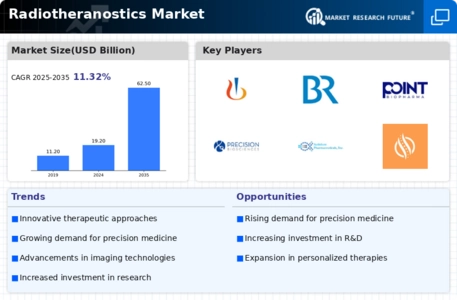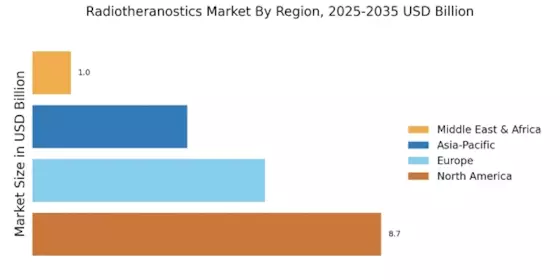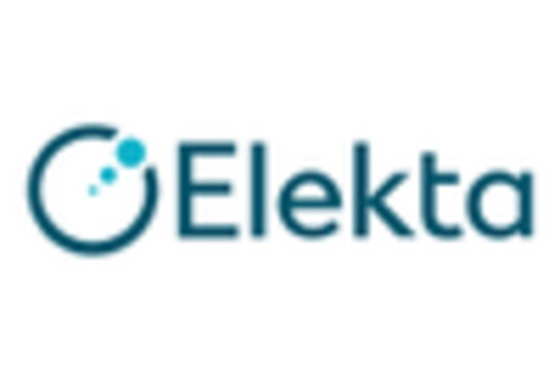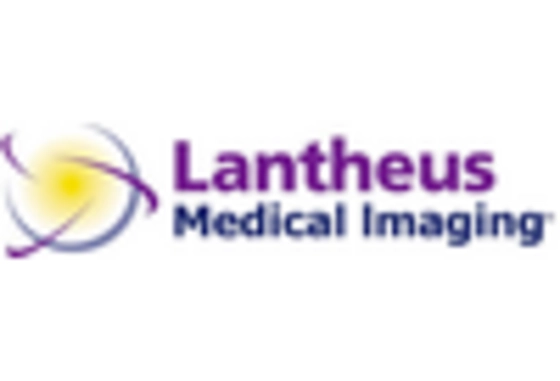Increasing Incidence of Cancer
The rising incidence of cancer worldwide is a primary driver for the Radiotheranostics Market. As cancer cases continue to escalate, the demand for effective treatment modalities increases correspondingly. According to recent statistics, cancer is projected to affect millions annually, necessitating innovative therapeutic solutions. Radiotheranostics Market, which combines targeted radiotherapy with diagnostic imaging, offers a promising approach to personalized cancer treatment. This dual capability not only enhances treatment efficacy but also minimizes side effects, making it a preferred choice among healthcare providers. The growing awareness of the benefits of radiotheranostics is likely to propel market growth, as patients and clinicians seek advanced options for cancer management. Furthermore, the integration of radiotheranostics into clinical practice is expected to improve patient outcomes, thereby reinforcing its position within the broader oncology landscape.
Growing Investment in Cancer Research
Growing investment in cancer research is a significant driver for the Radiotheranostics Market. Increased funding from both public and private sectors is facilitating the exploration of novel radiotheranostic agents and their applications. Research initiatives are focusing on the development of targeted therapies that leverage the unique properties of radiopharmaceuticals. This influx of capital is likely to accelerate the pace of innovation, leading to the discovery of new compounds that can enhance treatment outcomes. Furthermore, collaborative efforts among academic institutions, pharmaceutical companies, and research organizations are fostering a conducive environment for breakthroughs in radiotheranostics. As investment continues to rise, the market is poised for substantial growth, with the potential to revolutionize cancer treatment paradigms.
Rising Demand for Personalized Medicine
The rising demand for personalized medicine is a crucial driver for the Radiotheranostics Market. Patients and healthcare providers are increasingly seeking tailored treatment approaches that consider individual patient characteristics, including genetic profiles and tumor biology. Radiotheranostics Market aligns well with this trend, as it enables targeted therapy based on specific biomarkers. The market for personalized medicine is projected to expand significantly, with estimates indicating a CAGR of over 12% in the next few years. This growth is driven by advancements in genomic research and the increasing availability of diagnostic tests that inform treatment decisions. As personalized medicine becomes more prevalent, the role of radiotheranostics in providing customized therapeutic solutions is likely to gain prominence, further propelling market growth.
Technological Advancements in Imaging Techniques
Technological advancements in imaging techniques are significantly influencing the Radiotheranostics Market. Innovations such as positron emission tomography (PET) and single-photon emission computed tomography (SPECT) have enhanced the precision of radiotheranostic applications. These imaging modalities allow for accurate localization of tumors and assessment of treatment response, which is crucial for effective patient management. The market for imaging technologies is anticipated to grow, with estimates suggesting a compound annual growth rate (CAGR) of over 10% in the coming years. This growth is likely to be driven by the increasing adoption of hybrid imaging systems that integrate diagnostic and therapeutic capabilities. As imaging technologies continue to evolve, they will play a pivotal role in the development and implementation of radiotheranostic agents, thereby expanding their application in oncology and improving patient outcomes.
Regulatory Support and Approval for Radiopharmaceuticals
Regulatory support and approval for radiopharmaceuticals are vital drivers for the Radiotheranostics Market. Regulatory bodies are increasingly recognizing the potential of radiotheranostics in cancer treatment, leading to expedited approval processes for new agents. This trend is evident in the growing number of radiopharmaceuticals receiving market authorization, which enhances the availability of innovative treatment options. For instance, recent approvals have included novel radioligands that target specific cancer types, thereby improving therapeutic efficacy. The favorable regulatory environment is likely to encourage further investment in research and development, fostering innovation within the industry. As more radiopharmaceuticals gain approval, the market is expected to expand, providing healthcare professionals with a broader array of tools to combat cancer effectively.


















Leave a Comment